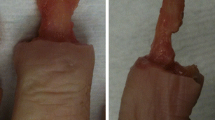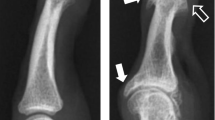Abstract
Background
The distal interphalangeal (DIP) joints of the hand are highly susceptible to osteoarthritis and trauma. Surgical treatment options mandate accurate characterization of their osseous anatomy; however, there are few studies that describe this. We describe the curvatures of the DIP joints by measuring the bone morphology using advanced imaging and modeling methods.
Methods
The fingers of 16 right hand fresh frozen human cadavers were analyzed. Fingers showing signs of DIP joint arthritis were excluded. The fingers were scanned using microtomography (microCT). Measurements of the bony morphology were made using models created from the scans.
Results
In each finger, there is no statistically significant difference between the radii of curvature of the ulnar and radial condyles of the middle phalanx head. Conversely, the radius of curvature of the distal phalanx ulnar groove is significantly greater than that of the radial groove. The radii of curvature of the groove of the distal phalanx and the condyles of the middle phalanx displayed nonconformity with disparity increasing from the index to small fingers. Remarkably, the radius of curvature of the distal phalanx central ridge and the mean radius of the middle phalanx condyles are essentially the same.
Conclusion
The purpose of this study is to gain better insight into the DIP joints of the hand. The asymmetry between the distal phalanx grooves and the middle phalanx condyles suggests that there may be a translational component to DIP joint motion. Our understanding of morphology may lend insight into the biomechanics and disease progression within the DIP joints.





Similar content being viewed by others
References
Ash HE, Unsworth A. Proximal interphalangeal joint dimensions for the design of a surface replacement prosthesis. Proc Inst Mech Eng H. 1996;210:95–108.
Bayer T, Schweizer A, Müller-Gerbl M, Bongartz G. Proximal interphalangeal joint volar plate configuration in the crimp grip position. J Hand Surg [Am]. 2012;37(5):899–905.
Beaupré GS, Stevens SS, Carter DR. Mechanobiology in the development, maintenance, and degeneration of articular cartilage. J Rehabil Res Dev. 2000;37:145–51.
Bowers WH, Wolf JW, Nehil JL. The anatomy of the interphalangeal joints. In: Bowers WH, editor. The interphalangeal joints. New York: Churchill Livingstone; 1987. p. 2–28.
Buckwalter JA, Martin JA. Osteoarthritis. Adv Drug Deliv Rev. 2006;58:150–67.
Degeorges R, Parasie J, Mitton D, et al. Three-dimensional rotations of human three-joint fingers: an optoelectronic measurement. Preliminary results. Surg Radiol Anat. 2005;27:43–50.
Dumont C, Albus G, Kubein-Meesenburg D, et al. Morphology of the interphalangeal joint surface and its functional relevance. J Hand Surg [Am]. 2008;33(1):9–18.
Genant HK, Engelke K, Prevrhal S. Advanced CT bone imaging in osteoporosis. Rheumatology (Oxford). 2008;47(4):iv9–16.
Lawrence T, Trail IA, Noble J. Morphological measurements of the proximal interphalangeal joint. J Hand Surg (Br). 2004;29:244–9.
Lehto TU, Ronnemaa TE, Aalto TV, et al. Roentgenological arthrosis of the hand in dentists with reference to manual function. Comm Dent Oral Epidemiol. 1990;18:37–41.
McArthur PA, Cutts A, Milner RH, et al. A study of the dimensions and taper angles of the medullary canals of the proximal and middle phalanges. J Hand Surg (Br). 1998;23:24–7.
Piscoya JL, Fermor B, Kraus VB, et al. The influence of mechanical compression on the induction of osteoarthritis-related biomarkers in articular cartilage explants. Osteoarthritis Cartilage. 2005;13:1092–9.
Saito S, Suzuki S, Suzuki Y. Biomechanical differences of the proximal interphalangeal joint volar plate during active and passive motion: a dynamic ultrasonographic study. J Hand Surg [Am]. 2012;37(7):1335–41.
Wilder FV, Barrett JP, Farina EJ. Joint-specific prevalence of osteoarthritis of the hand. Osteoarthritis Cartilage. 2006;14:953–7.
Conflicts of Interest
Kraig S. Graham declares that he has no conflict of interest. Robert J. Goitz declares that he has no conflict of interest. Robert A. Kaufmann declares that he has no conflict of interest.
Statement of Human Rights
All procedures followed were in accordance with the ethical standards of the responsible committee on human experimentation (institutional and national) and with the Helsinki Declaration of 1975, as revised in 2008.
Statement of Informed Consent
No personal identifying information was used in this manuscript, and the research was performed on cadaver specimens; therefore, informed consent was not needed nor obtained.
Author information
Authors and Affiliations
Corresponding author
Additional information
Partial funding for this project was received from Albert B. Ferguson, M.D. Orthopaedic Fund of the Pittsburgh Foundation
About this article
Cite this article
Graham, K.S., Goitz, R.J. & Kaufmann, R.A. Curvatures of the DIP joints of the hand. HAND 9, 522–528 (2014). https://doi.org/10.1007/s11552-014-9605-2
Published:
Issue Date:
DOI: https://doi.org/10.1007/s11552-014-9605-2




